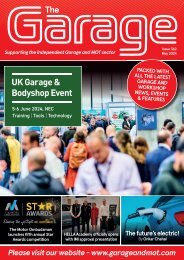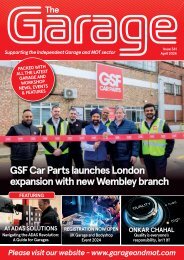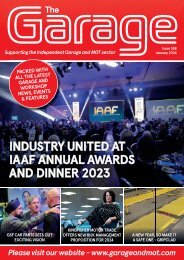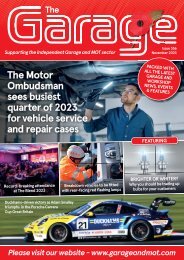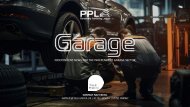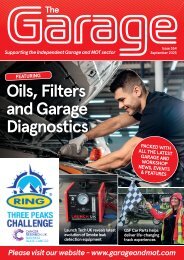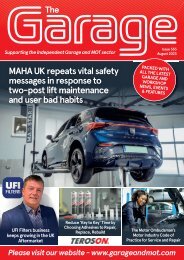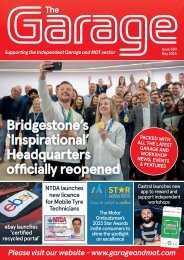Professional Recovery 354
Create successful ePaper yourself
Turn your PDF publications into a flip-book with our unique Google optimized e-Paper software.
RECOVERYINSIDER<br />
restrictions you can easily see why it could add further confusion.<br />
The best example for me is a very simple bus lane, now I can<br />
guarantee almost every reader has done this and been in two minds<br />
whether to use a bus lane or not in the hours where it is allowed,<br />
dithering over should I or shouldn’t I use the hard shoulder, causing<br />
their concentration to waiver. Ultimately, they are trying to avoid<br />
a fine. In the dynamic hard shoulder scenario it could be a bigger<br />
safety risk than we may think, versus the current issues.<br />
There was a clear plan from Government and National Highways<br />
to end up with only two types of motorways, a conventional<br />
motorway with a hard shoulder and one single type of managed<br />
motorway, this was intended to be the All-Lane Running (ALR).<br />
National Highway’s plan was to do away with added confusion of<br />
“open the lane – close the lane” and educate all road users and to<br />
use the Red X lane closure for all incidents, so doing away with the<br />
three smart motorway options making it simpler and less confusing;<br />
l Dynamic hard shoulder: where the hard shoulder is temporarily<br />
opened up to traffic.<br />
l All lane running: where the full width of the road is usable with<br />
emergency refuge areas alongside.<br />
l Controlled motorway: with three or more lanes, a hard shoulder<br />
and variable speed limits.<br />
The migration over to only ALR was scheduled to be completed<br />
by March 2025, part of the 18-point action plan from 2020, the<br />
rationale behind this was to reduce confusion, however this<br />
could be about to change, because The Transport Committee<br />
has released its latest report where National Highways agrees to<br />
undertake a full 5-year review of all available data before continuing<br />
with the conversion.<br />
This latest report spans 35 pages of evidence-based reporting,<br />
18 separate select committee reports, plus written evidence from<br />
94 respondents and 188 separate pieces of evidence. It describes<br />
in detail the involvement of the Office of Road and Rail who will<br />
undertake to review the data.<br />
Fundamental misgivings<br />
The report sets out to highlight the fundamental misgivings<br />
of the previous Highways England and the lack of action and<br />
improvements that was promised back in 2016, following the<br />
then Transport Select Committee report. Unfortunately, it does<br />
not show any of the positive work that is now being undertaken,<br />
positive work that has definitely improved the safety of the recovery<br />
operator.<br />
Not wishing to repeat myself, but the CSRRR and Richard<br />
Goddard’s formation of the <strong>Professional</strong> <strong>Recovery</strong> Operators<br />
Federation PROF was the catalyst behind the independent operator<br />
strategic partnership with the then Highways England now National<br />
Highways (NH) and the beginning of real dialog and change.<br />
From those early days of finding fault and bringing to task the<br />
then Highways England’s, questioning and highlighting issues and the<br />
dangers with smart motorways. Remembering that rare opportunity<br />
that Richard and the late Dave Gregory had to give evidence on<br />
behalf of the independent recovery operator in 2016, was without<br />
doubt the marker in the sand for change. Following on from that<br />
came interviews on national TV plus regular radio appearances on<br />
LBC radio.<br />
The barrage of criticism aimed at Highways England brought<br />
about a memorable meeting with them and PROF, where a positive<br />
decision was made to work with them and not against them.<br />
Working with them to improve the safety of the 345 miles of smart<br />
motorways, rather than wasting time and effort fighting against<br />
them, as many still choose to do. Effort would be far better used<br />
to work with National Highways to improve the network and overall<br />
safety.<br />
This latest Transport Committee report demonstrates the culture<br />
change within National Highways. From the previous Chief Executive<br />
who chose to dismiss the independent recovery industry and ignore<br />
every effort we made to work with them, to today’s Chief Executive<br />
Nick Harris and his team who have taken the time to work with the<br />
recovery industry, understand our network, engage in regular dialog<br />
and to improve roadside safety.<br />
This relationship has already delivered great things for the<br />
recovery industry, the strategic partnership and now additional<br />
partnership agreements with the independent work providers and<br />
the tyre industry with the National Tyre Distributors Association<br />
NTDA.<br />
Major improvements<br />
Some major improvements the independent operators have<br />
been asking for, for years but that had never listened too, signage<br />
on the motorway gantry’s indicating that recovery personnel<br />
are working, there is now specific protocols within the National<br />
Highways control rooms to action these signs.<br />
A National Highways – Independent <strong>Recovery</strong> Operators<br />
Executive Group, where the independents have their voice heard,<br />
it follows that there are also regional working groups where local<br />
issues can be raised.<br />
For the very first time the independent recovery industry was<br />
included in the latest update to the highway code, consulted on,<br />
listened to and now clause 264:<br />
“Be aware of emergency services, traffic officers, recovery workers<br />
and other people or vehicles stopped on the hard shoulder or in an<br />
emergency area. If you are driving in the left lane, and it is safe to do<br />
so, you should move into the adjacent lane to create more space<br />
between your vehicle and the people and stopped vehicles.”<br />
The latest Transport Committee report ‘Rollout and safety<br />
of smart motorways’ - this in-depth 43-page report Transport<br />
10 PROFESSIONAL RECOVERY MAGAZINE<br />
8, 9, 10, 11 DF.indd 3 18/01/2022 09:01





